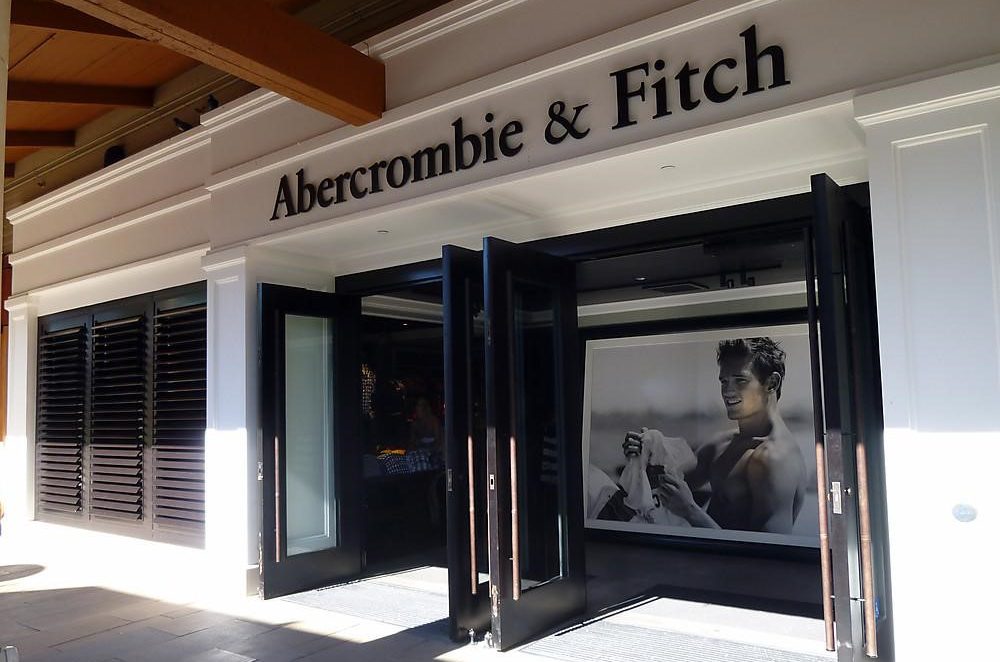Abercrombie & Fitch: A Worthy Lesson Learned in Fashion Industry

Once a thriving brand seen within millions teenage wardrobe, Abercrombie & Fitch have in recent years been failing, in part due to their refusal to update their brand strategies and old-fashioned ways of sexual exploitative marketing campaigns to reflect the new norm of feminism and equality.
With the rapidly involving of social media and digital sectors, it takes over a key marketing tool within fashion industry. This is also a great way to measure the success of a brand and implement changes to customers all over the world. A strong identity and positive reputation would be built back over time, regaining the trust of many customers and increasing their share on the trade market.
The Brand of Innovators and Exceptional Styles
Abercrombie & Fitch Co. is a leading, global specialty retailer of apparel and accessories for Men, Women and Kids through three renowned brands. In 1892 in the United State, Abercrombie Co. was founded by David Abercrombie as an elite outfitter of sporting and excursion goods and professional weapons. For more than 125 years, the iconic Abercrombie & Fitch brand has outfitted innovators, explorers and entrepreneurs.
By 1939 Abercrombie & Fitch was “The Greatest Sporting Goods Store in the World”.
In 2000s, Hollister Co. launched by Abercrombie. This brand has a new concept focused on the optimistic, laidback California lifestyle. The Hollister brand epitomizes the liberating and carefree spirit of the endless California summer for the teen market. Abercrombie kids creates smart, playful apparel for children ages 5-14, celebrating the wide-eyed wonder of childhood.
The brands share a commitment to offering products of enduring quality and exceptional comfort that allow consumers around the world to express their own individuality and style. The Company operates more than 850 stores under these brands across North America, Europe, Asia and the Middle East, as well as the e-commerce sites, www.abercrombie.com and www.hollisterco.com.

This Company Used to Hit Its Zenith
The core of Abercrombie & Fitch business model is the store – not only because that is where major sales take place but also because it is the main communication channel for the brand image. The careful and meticulous design of the shopping experience is the brand’s main engine, influencing the clients’ affective and emotional side. Abercrombie and Fitch have not only helped people dress properly but has also shared a sense of fashion. Two main offshoot brands of Abercrombie & Fitch namely are Abercrombie kids and Hollister Co. American Eagle outfits and Aeropostale are the two contemporaries giving Abercrombie some serious goals.
In 1992, Mike Jeffries became CEO when Abercrombie’s sales were languishing. He turned the brand into a retail powerhouse by plastering the Abercrombie logo all over its offerings, focusing on a more preppy, casual aesthetic, and then sexing it up with racy advertising and selling it at steep prices. Mike Jeffries has turned Abercrombie into a status symbol and transformed this brand into a very sexy teen store.
He made Abercrombie seem like an exclusive club that bestowed its logo on thin, tan, popular teens with lots of cash to spend. The advertising, which featured frolicking, half-naked co-eds, upset many parents — but that made the brand even more attractive to their kids.
Business Strategy of Abercrombie & Fitch: Then and Now
Years ago, Abercrombie hit some controversial roadblocks. In 2002, the company received backlash for products that were perceived as offensive. Abercrombie has transformed many times over the years. It’s turned up the lights in its stores, ditched its shirtless models, and traded overly sexualized ads for wholesome, outdoorsy images in an effort to appeal to the trendy millennial consumer. The company is continuing to ramp up its efforts to reach these customers in other places and spread awareness about its new image.

Although A&F had a clear target of positioning itself in top of the mind, it has not been able to achieve the same. A decade back, A&F marketing was strong and hence it had Top of Mind awareness. Today, the brand has lost its “cool” and “hip” appeal and is doing well overall but not with the same pace it was growing a decade back. In 2012, the brand was 474th highest brand in the world as per Forbes. Since then, the brand has lost further brand equity and is not in the top 500 as of 2016. In 2014, the brand posted a severe loss. It has also lost its premium positioning because the youth do not feel connected with the brand.
Abercrombie & Fitch has been working hard to execute a turnaround — it’s investing in stores, improving its product assortment, and working on its marketing strategy. The retailer is in the midst of a major turnaround effort led by CEO Fran Horowitz, who took the helm in 2017. They are doing everything it can to shed its teen image.
In 2019, Abercrombie & Fitch said it was closing three more flagship stores — in Soho, New York, Fukuoka, Japan and Milan, Italy — alongside results that highlighted falling revenues from its overseas businesses, adding to concerns about the health of bricks-and-mortar retail.
Abercrombie & Fitch Co. plans to increase marketing spend in 2020. “We plan to make further marketing investments in experiences: communicating with our target customer through the right channels and creating authentic, customer-inspired events,” a spokesperson for Abercrombie & Fitch told. Its turnaround strategy seems to be working. In June, Abercrombie & Fitch announced its second quarter of consecutive growth — same-store sales at the Abercrombie brand itself were up 3%, and overall, sales were up 5%, thanks in part to strong sales at Hollister, its teen sister brand.
Business experts always say that the problem with the distribution strategy of A&F has been that its distribution was not well planned. It is losing market share in its own home ground which is the US due to branding reasons. But outside US, it does not have a high share in Middle East or Asian countries which has affected the overall revenue of the brand.
What Is Wrong with Abercrombie & Fitch?
Despite being one of the major fashion distribution groups and having achieved lots of successful results, nowadays A&F is facing a bad economic situation driven by a negative trend in its income statement. After witnessing this situation, shareholders have requested a change of strategy.

Abercrombie & Fitch has received criticism for its provocative advertising and has been involved in legal conflicts regarding clothing style, employment discrimination practices and advertising campaigns, which have been described as sexually explicit and racist. The company has come under fire for the comments that Mike Jeffries made when he was asked about the company’s philosophy.
One of the issues for which Abercrombie & Fitch received a lot of flak was their handling of employees. Employees were made to wear only A&F branded clothing which they had to buy a discounted price from the brand. This issue was resolved a few years back with employees being compensated. Overall, there have been several poor policies with regards to employee management by A&F over time.
Not only were they involved in employee management hassles, the marketing and advertising of A&F also received flak from people due to their usage of partially nude men and bold ads over the years. The brands have a list of controversies they were involved in all over news and articles. An increasing number of Millennial and Generation Z consumers are becoming aware of the social factors impacting on the products that they buy and content they interact with. This could cause major problems for this brand, especially Abercrombie & Fitch had given their previous infamous strategies, known to feature the sexualization of young teen models.
The A&F catalog was also arguably one of the most talked-about advertising vehicles in history. Parents hated its blatant sexuality, which was in part why kids were drawn to it. It even resulted in legal issues for the brand when they were shamed for keeping non-white and disabled employees in the backroom jobs.

Another point of view, A&F failed to see the changes and let the competitors sneak in. It totally missed the logic that every business needs an inflow of new customers. You need old customers to stay, but you need new customers to join into your market share, too. As they grow older, the old customers usually would lose interest in a product and might go for another product or the circumstances they were in might force them to change. Their financial position or their study or job requirements might alter their way of life. A high school student can’t wear the same type of fashion clothes when they go to university or take up a job at a place where the dress code is a prerequisite.
Abercrombie & Fitch became a cool brand since Mike Jeffries rebranded them as the upscale brand it became. However, over a period, Abercrombie and fitch lost most of its “coolness” and young college crowd could not associate themselves with A&F due to which it has lost a major market share.
How Abercrombie & Fitch Brand Conquers the Market!
As a heritage brand, Abercrombie & Fitch have lots of history to rely on and use their advantages through their products and marketing campaigns. It is also important for this brand to show they have evolved their images and still relatable to modern trends now to keep from looking dated and unfashionable.
They are used to now for their quality products, although the customers do understandably have to compromise on price for the brand to achieve this. Many customers will not take issue with this if only they realized the needs to invest clothes which will last longer, breaking the fast fashion cycle and creating a more sustainable way forward.
#1 Market penetration and expansion
Like any other retail brand, Abercrombie and Fitch has a lot of potential if it starts expanding to many developing countries. A&F must decide between being a niche failing brand or a massive up to date brand. Hence, market expansion is necessary now for A&F.
One avenue of long-term growth is the company’s online business. A fundamental shift from brick-and-mortar to the online platform is evident, and retail companies must embrace this trend in order to remain relevant.
Abercrombie & Fitch hopes to get some of its mojo back with a new focus on college students who are more in tune with mobile loyalty programs and lower price points than fickle teenagers. According to Sheryl Kingstone – Toronto-based research director at Yankee Group: “Once Hollister and A&F make changes to their merchandise plan, they must think mobile-first”. “Customers will choose to shop at a business, which offers mobile loyalty programs for rewards and in-store engagement with value added information on products, H&M and Kohl’s do this very well while also offer a strong merchandising plans.” she said.
Abercrombie’s digital store-centric capabilities such as purchase online, pick up in store have been driving traffic to stores and as a result, spurring the purchases and productivity within the store. The company has a robust omnichannel functionality in markets such as the US, Canada, and the UK. These capabilities are being introduced in its other markets as well, which is a necessary area of focus for driving international growth.
#2 Franchising as an option

Franchising should be considered by Abercrombie & Fitch because it is a respected brand within US as well as outside US. It needs to leverage its brand equity to expand faster and like Adidas, A&F can enter franchising and increase its base.
The business development at Abercrombie & Fitch has always been specific about reaching out to their real customers and serving an experience. With 300 locations in United States and with the ongoing expansion, Abercrombie and Fitch aims to be accessible to everyone in the world.
Abercrombie & Fitch launched products that will allow people have a complete makeover makes it the best apparel enterprise in the contemporary world. An apparel enterprise that provides people with credit facility via its credit card & helps people develop intricate understanding of brand and creates trust as well.
#3 Advertising and rebuild their brand image
A&F needs to advertise and build its brand locally in the developing countries that it is expanding in. It cannot continue with the same legacy it has built in the US. US is the home ground of A&F and if its sales figures are dropping in its home ground, then there is something wrong with the brand. A&F needs to get at the top of their game and push hard in conquering the lost market share soon.
The brand always tries to make a resonation between their products and the image they tend to create.
The lack of marketing can create issues as many consumers will forget about the brand and automatically visit the same competitors repeatedly. The Abercrombie & Fitch social media platforms are in need of a makeover to keep their content from becoming lost within oversaturated timelines. Across the three main social media platforms, Instagram, Facebook and Twitter, this brand keeps they’re their consistent. These platforms all have spectacle numbers of followers; however, post engagement is low, perhaps due to the desaturated color pallets match with generic. One solution is to create a more globally rounded platform to integrate with more international customers, something the brand is struggling with. With the right advertising campaigns, this brand can reach to new potential customers.








